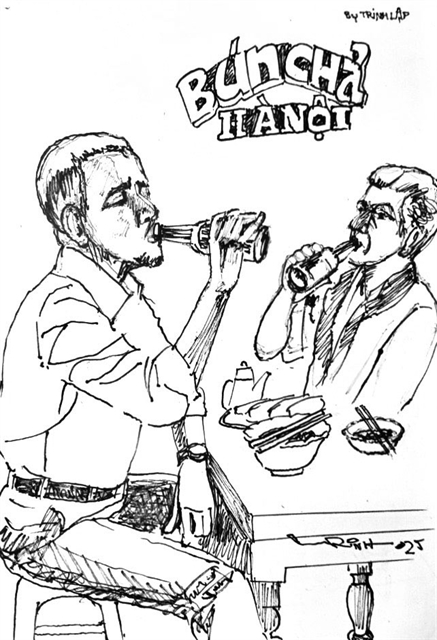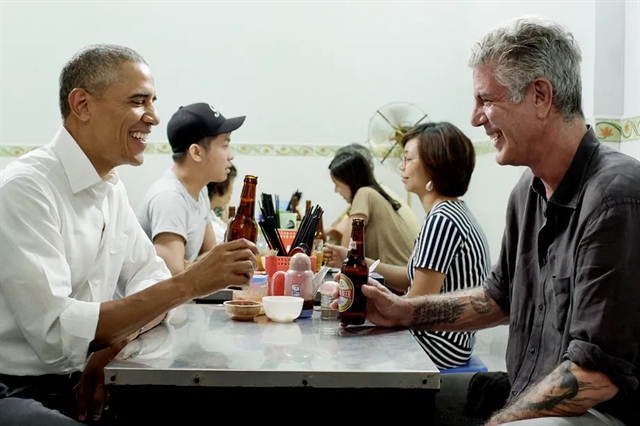 Talk Around Town
Talk Around Town

 |
| Tourists line up to buy Phượng’s bánh mì in Hội An. Photo Khương Mỹ/ttvn.toquoc.vn |
By Trần Khánh An
Bánh Mì Phượng was established in 1990 as a small stall by a local woman in the ancient town of Hội An, Quảng Nam Province. In 2009, its fate thoroughly changed when Anthony Bourdain introduced her food on his show No Reservations and described her bánh mì as 'a symphony' of flavours.
The restaurant gained instant fame worldwide, and with that newfound fame came an influx of tourists. From a humble stall in the market, it moved to the main street in the centre of the town.
Owner Trương Thị Phượng says that the restaurant serves 2,000 bánh mì a day, mainly for tourists. During peak hours, customers may have to wait up to 30 minutes for their food.
From a small, family-run stall, since the episode aired 16 years ago, Bánh Mì Phượng has been featured on just about every to-do list for travellers to Hội An.
 |
| Illustration by Trịnh Lập |
A visit to an eatery by Bourdain, or any other celebrity chef of a similar ilk, can be life-changing for that particular restaurant. In their own right, they become stand-alone tourist destinations.
Throw a President of the United States into the mix, as Bourdain did when he took Barack Obama to Bún Chả Hương Liên [rice noodles with grilled pork shop] in central Hà Nội in 2016, and the PR takes on a life of its own.
There’s nothing wrong with trusting the recommendation of such a culinary icon, but it’s not always gravy.
Many of the lesser-known restaurants in the city serving just as good, or even better and cheaper, dishes are often overlooked by international tourists who are desperate to eat exactly where Bourdain ate.
But here’s the thing: I have no doubt he also ate and enjoyed many meals in nondescript spots without a camera crew. There isn’t just one 'lunch lady' – Việt Nam is full of lunch ladies, dinner ladies, and snack vendors everywhere you go.
And sometimes, fame can be more of a burden than a blessing. While spots like Bánh Mì Phượng or Bún Chả Hương Liên have the resources to adapt and handle large crowds, smaller, family-run restaurants aren’t always prepared for a sudden surge of tourists. Take O Lé, a small eatery featured in Parts Unknown, for example.
Last month, I visited O Lé in Huế, 11 years after they were featured on the show. There were about 50 customers in a tiny place, mostly tourists, but only four family members ran the entire business, handling everything from taking orders to cooking, serving, and clearing tables. The young woman at the front kept apologising for the delays.
 |
| O Lé eatery in Huế is often crowded with customers. VNS Photo Trần Khánh An |
Among the customers in line, many were international visitors, and I could see the excitement in their eyes as they eagerly tried to follow in Bourdain’s footsteps. But after waiting more than an hour and still not getting everything I ordered, I couldn’t help but wonder what they thought of the meal and the experience as a whole.
Sure, visiting the places Bourdain featured is a way of honouring his endorsement; however, if we approach it merely as checking off boxes of must-see spots, much like collecting football cards or spotting trains, does that go against what he truly advocated for?
I am too young to truly understand Bourdain's impact on the restaurant industry and TV storytelling when he was alive. However, from what I've understood, what makes his culinary journey different from a typical food show is the way he uses food and travel as a gateway to explore the authentic, unfiltered and overlooked parts of the world.
For him, putting behind-the-scenes cuisines, cultures and people at the forefront goes far beyond finding an edgy or adventurous food experience to draw in more viewers. It is about recognising marginalised communities and businesses with fewer resources.
When you choose to eat at small, locally owned businesses that are not on the usual tourist path, you are doing more than just enjoying a meal. Every penny stays within the neighbourhood, helping families make ends meet, sending their children to school and keeping traditions alive. Each meal becomes a helping hand towards building a more inclusive and resilient local economy.
 |
| US President Barack Obama with Anthony Bourdain at Bún chả Hương Liên Restaurant in Hà Nội in 2016. Photo courtesy of CNN |
I understand that it is easy to be influenced by celebrity chefs, social media reviews that trigger our fear of missing out or the pressure of having a perfect trip. However, if you cling too tightly to a carefully curated travelling checklist of tourist-filled restaurants, you miss the raw thrill of discovery – something Bourdain deeply understood.
“If you don’t risk the bad meal, you’ll never get the magical one,” he once said.
Sometimes, the most memorable experiences come not from a guidebook, but unscripted moments where you find a location's true flavour. We might miss the instinctive pull in your gut that guides you to a street food stall packed with locals, or the quiet satisfaction of trusting a local and realising that their favourite hidden spot is better than you imagined.
And most importantly, you miss the chance to discover stories behind the dishes – stories that bring you closer to the people who cook them and the culture and history they come from. And in doing so, you miss a moment that reminds you how little we know and that we are all part of something much bigger than ourselves.
The magical meal is not always just about flavours, it is about the more profound meanings found in conversations around a communal table.
To truly honour what Bourdain stood for is not to idolise his exact map, but to embrace his spirit, to stay curious, open-hearted and willing to listen. Don't just follow in his footsteps; instead, find your favourite eateries and create your own experience with the places you visit – he would be proud of you.
Let’s leave the final words to the late New Yorker himself.
“Meals are what hold society together in ways that are charming, interesting and captivating to me. The best meals often happen in a context that has little to do with the food itself.” VNS









